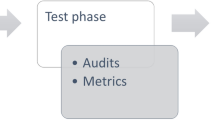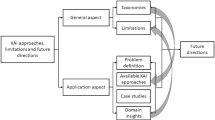Abstract
The growing use of Information Technology in the commercial arena leads to an urgent need to find alternatives to traditional dispute resolution. New tools from fields such as artificial intelligence (AI) should be considered in the process of developing novel online dispute resolution (ODR) platforms, in order to make the ligation process simpler, faster and conform with the new virtual environments. In this work, we describe UMCourt, a project built around two sub-fields of AI research: Multi-agent Systems and Case-Based Reasoning, aimed at fostering the development of tools for ODR. This is then used to accomplish several objectives, from suggesting solutions to new disputes based on the observation of past similar disputes, to the improvement of the negotiation and mediation processes that may follow. The main objective of this work is to develop autonomous tools that can increase the effectiveness of the dispute resolution processes, namely by increasing the amount of meaningful information that is available for the parties.



















Similar content being viewed by others
References
Aamodt A, Plaza E (1994) Case-based reasoning: foundational issues, methodological variations, and system approaches. AI Commun 7(1):39–59
Alterman R (1989) Panel discussion on case representation. In: Proceedings of the second workshop on case-based reasoning, Pensacola Beach
Andrade F, Barbieri D, Carneiro D, Novais P (2010) Artificial intelligence applications in ODR: the UMCourt project. In: Proceedings of the 17th annual northwest dispute resolution conference, University of Washington, USA
Ashley KD (2004) Case-based models of legal reasoning in a civil law context. In: International congress of comparative cultures and legal systems of the instituto de investigaciones jurídicas
Behrman BW, Davey SL (2001) Eyewitness identification in actual criminal cases: an archival analysis. Law Hum Behav 25(5):475–491
Bellifemine F, Poggi A, Rimassa G (2008) Developing Multi-agent Systems with JADE. Springer, Berlin
Bellucci E, Zeleznikow J (2001) Representations of decision-making support in negotiation. J Decis Syst 10(3–4):449–479
Bellucci E, Lodder A, Zeleznikow J (2004) Integrating artificial intelligence, argumentation and game theory to develop an online dispute resolution environment. In: Proceedings of the ICTAI-2004—16th IEEE international conference on tools with AI, pp 749–754
Bellucci E, Zeleznikow J (2006) Developing negotiation decision support systems that support mediators: a case study of the family winner system. J Artif Intell Law 13(2):233–271
Brown H, Marriott A (1999) ADR principles and practice. Sweet& Maxwell, London
Cáceres E (2008) EXPERTIUS: a Mexican judicial decision-support system in the field of family law. In: Francesconi EBE, Sartor G, Tiscornia D (eds) Legal knowledge and information systems. IOS Press, Amsterdam, pp 78–87
Carneiro D, Novais P, Andrade F, Zeleznikow J, Neves J (2009) The legal precedent in online dispute resolution. In: Legal Knowledge and Information Systems, Guido Governatori (eds) Proceedings of the Jurix 2009—the 22nd international conference on legal knowledge and information systems, IOS press, pp 47–52. ISBN 978-1-60750-082-7
Carneiro D, Novais P, Costa R, Neves J (2010) Enhancing the role of multi-agent systems in the development of intelligent environments. Advances in intelligent and soft computing, vol 71. Springer, pp 123–130. ISBN 978-3-642-12432-7
De Vries BR, Leenes R, Zeleznikow J (2005) Fundamentals of providing negotiation support online: the need for developing BATNAs. In: Proceedings of the second international ODR workshop, Wolf Legal Publishers, Tilburg, pp 59–67
Fernandes AM (2005) Direito de trabalho, Almedina, (in Portuguese)
Foundation for Intelligent physical Agents: FIPA ACL message structure specification (2002) available at http://www.fipa.org/specs/fipa00061, accessed in August 2012
Fisher R, Ury W (1991) Getting to YES: negotiating agreement without giving. In: Penguin books, ISBN 978-0140157352
Follett MP (1940) Constructive conflict. In: Metcalf HC, Urwick IL (eds) Dynamic administration: the collected papers of Mary Parker Follett. Harper, New York, pp 30–49
Foxall G (2004) What judges maximize: towards an economic psychology of the judicial utility function. Liverp Law Rev 25:177–194
Fudenberg DA, Tirole J (1983) Game theory, Chapter 1, Section 2.4. MIT Press
Goldberg SB, Sander FE, Rogers N et al (2003) Dispute resolution: negotiation, mediation and other processes. Aspen Publishers, New York
Goodman JW (2003) The pros and cons of online dispute resolution: an assessment of cyber-mediation websites. Duke Law Technol Rev, pp 1–16
Hasan M, Salem S, Zaki M (2010) SimClus: an effective algorithm for clustering with a lower bound on similarity. Knowl Inf Syst. doi:10.1007/s10115-010-0360-6
INCM (2009) Código do Trabalho (in Portuguese)
Jennings N, Faratin P, Lomuscio A et al (2001) Automated negotiation: prospects, methods and challenges. Group Decis Negot 10(2):199–215
Katsch E, Rifkin J (2001) Online dispute resolution–resolving conflicts in cyberspace. Jossey-Bass Wiley Company, San Francisco
Klaming L, Van Veenen J, Leenes R (2008) I want the opposite of what you want: summary of a study on the reduction of fixed-pie perceptions in online negotiations. In: Expanding the horizons of ODR, Proceedings of the 5th international workshop on online dispute resolution, Firenze, Italy, pp 84–94
Landes WM, Posner RA (1976) Legal precedent: a theoretical and empirical analysis. J Law Econ 19:249–307
Lewicki R, Saunders D, Minton J (1999) Zone of potential agreement. Negotiation, 3rd edn. Irwin-McGraw Hill, Burr Ridge
Lynda T, Mohand B, Mariam D (2010) Evaluation of contextual information retrieval effectiveness: overview of issues and research. Knowl Inf Syst 24(1):1–34
Martinez PR, Monteiro L, Vasconcelos J, et al. (2008) Código do trabalho, Almedina, (in Portuguese)
Notini J (2005) Effective alternatives analysis in mediation: “BATNA/WATNA” analysis demystified. Available at http://www.mediate.com/articles/notini1.cfm. Last accessed August 2012
Peruginelli G, Chiti G (2002) Artificial Intelligence in alternative dispute resolution. In: Proceedings of the workshop on the law of electronic agents—LEA
Popple J (1996) A pragmatic legal expert system. Ashgate, Dartmouth
Posner RA (1993) What do judges and justices maximize. Supreme Court Econ Rev 3:1–41
Raiffa H (1982) Art and science of negotiation. Harvard University Press, Cambridge
Riesbeck C, Bain W (1987) A methodology for implementing case-based reasoning systems, Lockheed
Slade S (1991) Case-based reasoning: a research paradigm. AI Mag 12:42–55
Steinbach M, Tan PN, Kumar V (eds) (2005) Introduction to data mining. Pearson Addison Wesley, Boston
Tang M, Zhou Y, Li J, Wang W, Cui P, Hou Y, Luo Z, Li J, Lei F, Yan B (2010) Exploring the wild birds’ migration data for the disease spread study of H5N1: a clustering and association approach. Knowl Inf Syst 1–25. doi:10.1007/s10115-010-0308-x
Thiessen EM (1993) ICANS: an interactive computer-assisted multi-party negotiation support system. In: PhD dissertation, School of Civil and Environmental Engineering, Cornell University, Ithaca
Thiessen EM, McMahon JP (2000) Beyond win-win in cyberspace. Ohio State J Disput Resolut 15:643
Thiessen EM, Fraser K (2003) Mobile ODR with smartSettle. In: Proceedings of the UNECE Forum on ODR
Thomas K, Kilmann R (1974) Conflict and conflict management. Available at http://www.kilmann.com/conflict.html, accessed in August 2012
Walton PRE, McKersie RB (1965) A behavioral theory of labor negotiations. McGraw-Hill, New York
Waterman DA, Peterson M (1980) Rule-based models of legal expertise. In: Proceedings of the first national conference on AI, Stanford University
Watson I, Marir F (1994) Case-based reasoning: a review. Knowl Eng Rev 9:327–354
Wooldridge M, Jennings NR (1995) Intelligent agents: theory and practice. Knowl Eng Rev 10:115–152
Wooldridge M, Jennings NR, Kinny D (2000) The Gaia methodology for agent-oriented analysis and design. Auton Agents Multi-Agent Syst 3(3):285–312
Wooldrige M (2002) An introduction to multiagent systems. Wiley, London
Wu X, Kumar V, Quinlan JR et al (2007) Top 10 algorithms in data mining. Knowl Inf Syst 14(2008)1:1–37
Zeleznikow J, Stranieri A (1995) The split-up system: integrating neural networks and rule-based reasoning in the legal domain. In: Proceedings of the 5th international conference on artificial intelligence and law, ACM, College Park, pp 185–194
Zeleznikow J, Bellucci E (2003) Family-Winner: integrating game theory and heuristics to provide negotiation support. In: Proceedings of sixteenth international conference on legal knowledge based, system, pp 21–30
Zeleznikow J, Bellucci E (2004) Building negotiation decision support systems by integrating game theory and heuristics. In: Proceedings of the IFIP international conference on decision support systems. Monash University, Melbourne, Australia
Zeleznikow J, Bellucci E, Schild UJ, Mackenzie G (2007) Bargaining in the shadow of the law—using utility functions to support legal negotiation. In: Proceedings of the 11th international conference on artificial intelligence and law, ACM, pp 237–246
Zweigert K, Kötz H (1998) An introduction to comparative law, 3rd edn. Clarendon Press, Oxford
Acknowledgments
This work is funded by National Funds through the FCT—Fundação para a Ciência e a Tecnologia (Portuguese Foundation for Science and Technology) within project PEst-OE/EEI/UI0752/2011. The work of Davide Carneiro is also supported by a doctoral grant by FCT (SFRH/BD/64890/2009).
Author information
Authors and Affiliations
Corresponding author
Rights and permissions
About this article
Cite this article
Carneiro, D., Novais, P., Andrade, F. et al. Using Case-Based Reasoning and Principled Negotiation to provide decision support for dispute resolution. Knowl Inf Syst 36, 789–826 (2013). https://doi.org/10.1007/s10115-012-0563-0
Received:
Revised:
Accepted:
Published:
Issue Date:
DOI: https://doi.org/10.1007/s10115-012-0563-0




